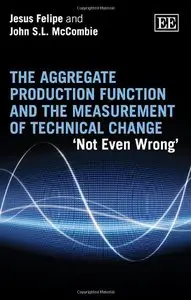The Aggregate Production Function and the Measurement of Technical Change by Jesus Felipe and John S.L. McCombie
English | 2013 | ISBN: 1840642556 | 352 pages | PDF | 4,2 MB
English | 2013 | ISBN: 1840642556 | 352 pages | PDF | 4,2 MB
This authoritative and stimulating book represents a fundamental critique of the aggregate production function, a concept widely used in macroeconomics.
The authors explain why, despite the serious aggregation problems that surround it, aggregate production functions often give plausible statistical results. This is due to the use of constant-price value data, rather than the theoretically correct physical data, together with an underlying accounting identity that relates the data definitionally. It is in this sense that the aggregate production function is 'not even wrong': it is not a behavioral relationship capable of being statistically refuted. The book examines the history of the production function and shows how certain seminal works on neoclassical growth theory, labor demand functions and estimates of the mark-up, among others, suffer from this fundamental problem.
The book represents a fundamental critique of the aggregate production function and will be of interest to all macroeconomists.
Contents: Prologue: 'Not Even Wrong' Introduction 1. Some Problems with the Aggregate Production Function 2. The Aggregate Production Function: Behavioural Relationship or Accounting Identity? 3. Simulation Studies, the Aggregate Production Function and the Accounting Identity 4. 'Are There Laws of Production?' The Work of Cobb and Douglas and its Early Reception 5. Solow's Technical Change and the Aggregate Production Function', and the Accounting Identity 6. What does Total Factor Productivity Actually Measure? Further Observations on the Solow Model 7. Why Are Some Countries Richer than Others? A Sceptical View of Mankiw-Romer-Weil's Test of the Neoclassical Growth Model 8. Some Problems with the Neoclassical Dual-Sector Growth Model 9. Is Capital Special? The Role of the Growth of Capital and its Externality Effect in Economic Growth 10. Problems Posed by the Accounting Identity for the Estimation of the Degree of Market Power and the Mark-up 11. Are Estimates of Labour Demand Functions Mere Statistical Artefacts? 12. Why Have the Criticisms of the Aggregate Production Function Generally Been Ignored? On Further Misunderstandings and Misinterpretations of the Implications of the Accounting Identity References Index



